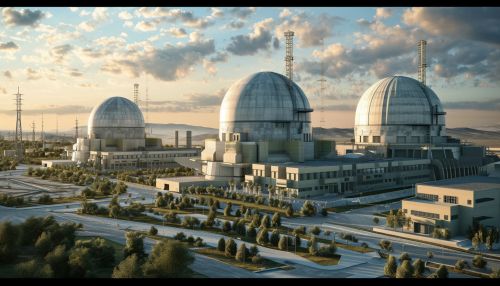Nuclear reactors
Introduction
A nuclear reactor is a device designed to maintain a chain reaction producing a steady flow of neutrons generated by the fission of heavy nuclei. They are, fundamentally, fast neutron reactors and thermal neutron reactors. The most commonly used reactors for nuclear power are thermal reactors that are moderated to create a thermal "slow" neutron spectrum.
History
The concept of a nuclear reactor was first realized in 1942 when Enrico Fermi and his team constructed and operated the world's first nuclear reactor, known as Chicago Pile-1, under the bleachers of the University of Chicago's Stagg Field.


Design and Construction
The design and construction of nuclear reactors involves a multitude of factors including the type of reactor, the use of the reactor, and the geographic location of the reactor. Reactors for power generation are typically in the gigawatt range. Reactors for research and training purposes are typically in the kilowatt to megawatt range.
Types of Nuclear Reactors
There are several types of nuclear reactors, but the most commonly used are Pressurized Water Reactors (PWRs) and Boiling Water Reactors (BWRs). Other types include Heavy Water Reactors (HWRs), Graphite Moderated Reactors, and Fast Neutron Reactors.
Pressurized Water Reactors (PWRs)
Pressurized Water Reactors are the most common type of thermal reactor, using uranium fuel, light water as the primary coolant and neutron moderator.
Boiling Water Reactors (BWRs)
Boiling Water Reactors operate similarly to PWRs, with the primary difference being that the water in the reactor core boils and turns into steam, which then drives the turbine generator.
Heavy Water Reactors (HWRs)
Heavy Water Reactors use heavy water, or deuterium oxide, as a coolant and neutron moderator. These reactors can use natural uranium as fuel, making them a potential choice for nations with limited uranium enrichment capabilities.
Graphite Moderated Reactors
Graphite Moderated Reactors use graphite as a neutron moderator, which allows for the use of unenriched uranium fuel.
Fast Neutron Reactors
Fast Neutron Reactors do not have a neutron moderator and rely on fast neutrons to sustain the chain reaction. They are typically used for plutonium production or for "burning" nuclear waste.
Nuclear Fuel Cycle
The nuclear fuel cycle is the series of industrial processes which involve the production of electricity from uranium in nuclear power reactors. Uranium is a relatively common element that is found throughout the world. It is mined in a number of countries and must be processed before it can be used as fuel for a nuclear reactor.
Safety and Accidents
Safety is a key concern in the design, construction, and operation of nuclear reactors. Despite the high level of inherent safety, accidents have occurred, the most notable being the Chernobyl disaster in 1986 and the Fukushima Daiichi nuclear disaster in 2011.
Decommissioning
Decommissioning of a nuclear reactor is a complex process involving decontamination, dismantling, and waste disposal. The process can take several decades and must be carried out with great care to avoid any release of radioactive materials.
Future of Nuclear Reactors
The future of nuclear reactors is a subject of much debate. While some believe that nuclear power is a necessary part of the solution to climate change, others argue that the risks and costs associated with nuclear power make it an unattractive option.
